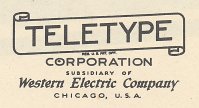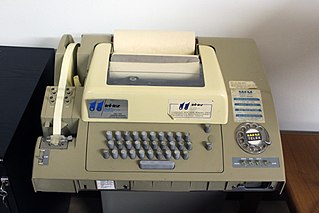
ASCII, abbreviated from American Standard Code for Information Interchange, is a character encoding standard for electronic communication. ASCII codes represent text in computers, telecommunications equipment, and other devices. Because of technical limitations of computer systems at the time it was invented, ASCII has just 128 code points, of which only 95 are printable characters, which severely limited its scope. Many computer systems instead use Unicode, which has millions of code points, but the first 128 of these are the same as the ASCII set.

Radioteletype (RTTY) is a telecommunications system consisting originally of two or more electromechanical teleprinters in different locations connected by radio rather than a wired link. Radioteletype evolved from earlier landline teleprinter operations that began in the mid-1800s. The US Navy Department successfully tested printing telegraphy between an airplane and ground radio station in 1922. Later that year, the Radio Corporation of America successfully tested printing telegraphy via their Chatham, Massachusetts, radio station to the R.M.S. Majestic. Commercial RTTY systems were in active service between San Francisco and Honolulu as early as April 1932 and between San Francisco and New York City by 1934. The US military used radioteletype in the 1930s and expanded this usage during World War II. From the 1980s, teleprinters were replaced by personal computers (PCs) running software to emulate teleprinters.

A teleprinter is an electromechanical device that can be used to send and receive typed messages through various communications channels, in both point-to-point and point-to-multipoint configurations. Initially they were used in telegraphy, which developed in the late 1830s and 1840s as the first use of electrical engineering, though teleprinters were not used for telegraphy until 1887 at the earliest. The machines were adapted to provide a user interface to early mainframe computers and minicomputers, sending typed data to the computer and printing the response. Some models could also be used to create punched tape for data storage and to read back such tape for local printing or transmission.

The VT100 is a video terminal, introduced in August 1978 by Digital Equipment Corporation (DEC). It was one of the first terminals to support ANSI escape codes for cursor control and other tasks, and added a number of extended codes for special features like controlling the status lights on the keyboard. This led to rapid uptake of the ANSI standard, which became the de facto standard for hardware video terminals and later terminal emulators.

A computer terminal is an electronic or electromechanical hardware device that can be used for entering data into, and transcribing data from, a computer or a computing system. The teletype was an example of an early-day hard-copy terminal and predated the use of a computer screen by decades.

The VT220 is a computer terminal introduced by Digital Equipment Corporation (DEC) in November 1983. The VT240 added monochrome ReGIS vector graphics support to the base model, while the VT241 did the same in color. The 200 series replaced the successful VT100 series, providing more functionality in a much smaller unit with a much smaller and lighter keyboard. Like the VT100, the VT200 series implemented a large subset of ANSI X.364. Among its major upgrades was a number of international character sets, as well as the ability to define new character sets.

The VT50 was a CRT-based computer terminal introduced by Digital Equipment Corporation (DEC) in July 1974. It provided a display with 12 rows and 80 columns of upper-case text, and used an expanded set of control characters and forward-only scrolling based on the earlier VT05. DEC documentation of the era refers to the terminals as the DECscope, a name that was otherwise almost never seen.

The Teletype Model 33 is an electromechanical teleprinter designed for light-duty office use. It is less rugged and cost less than earlier Teletype machines. The Teletype Corporation introduced the Model 33 as a commercial product in 1963; the machine had originally been designed for the United States Navy. There are three versions of the Model 33:

The Gold key is a computer keyboard key used as a prefix to invoke a variety of single-key editing and formatting functions. Usually located in the top-left position of the numeric keypad on platforms such as the VT100, it is the signature element of a consistent user interface implemented by Digital Equipment Corporation (DEC) across multiple product lines.

The Teletype Corporation, a part of American Telephone and Telegraph Company's Western Electric manufacturing arm since 1930, came into being in 1928 when the Morkrum-Kleinschmidt Company changed its name to the name of its trademark equipment. Teletype was responsible for the research, development and manufacture of data and record communications equipment, but it is primarily remembered for the manufacture of electromechanical teleprinters.
The delete control character is the last character in the ASCII repertoire, with the code 127. It is supposed to do nothing and was designed to erase incorrect characters on paper tape. It is denoted as ^? in caret notation and is U+007F in Unicode.

The telex network is a station-to-station switched network of teleprinters similar to a telephone network, using telegraph-grade connecting circuits for two-way text-based messages. Telex was a major method of sending written messages electronically between businesses in the post–World War II period. Its usage went into decline as the fax machine grew in popularity in the 1980s.
The Teletype Model 28 is a product line of page printers, typing and non-typing tape perforator and tape reperforators, fixed head single contact and pivoted head multi-contact transmitter-distributors, and receiving selector equipment. Regarded as the most rugged machines Teletype Corporation built, this line of teleprinters used an exchangeable type box for printing and sequential selector "Stunt Box" to mechanically initiate non-printing functions within the typing unit of the page printer, electrically control functions within the page printer and electrically control external equipment.

The Teletype Model 37 is an electromechanical teleprinter manufactured by the Teletype Corporation in 1968. Unfortunately the end was approaching for electromechanical user interfaces and a year later in 1969 the Computer Terminal Corporation introduced the electronic terminal with a screen.
Code page 1101, also known as CP1101, is an IBM code page number assigned to the UK variant of DEC's National Replacement Character Set (NRCS). The 7-bit character set was introduced for DEC's computer terminal systems, starting with the VT200 series in 1983, but is also used by IBM for their DEC emulation. Similar but not identical to the series of ISO 646 character sets, the character set is a close derivation from ASCII with only code point 0x23 differing.
Code page 1103, also known as CP1103, or SF7DEC, is an IBM code page number assigned to the Finnish variant of DEC's National Replacement Character Set (NRCS). The 7-bit character set was introduced for DEC's computer terminal systems, starting with the VT200 series in 1983, but is also used by IBM for their DEC emulation. Similar but not identical to the series of ISO 646 character sets, the character set is a close derivation from ASCII with only nine code points differing.
Code page 1020, also known as CP1020, is an IBM code page number assigned to the French-Canadian variant of DEC's National Replacement Character Set (NRCS). The 7-bit character set was introduced for DEC's computer terminal systems, starting with the VT200 series in 1983, but is also used by IBM for their DEC emulation. Similar but not identical to the series of ISO 646 character sets, the character set is a close derivation from ASCII with only ten code points differing.
Code page 1021, also known as CP1021 or CH7DEC, is an IBM code page number assigned to the Swiss variant of DEC's National Replacement Character Set (NRCS). The 7-bit character set was introduced for DEC's computer terminal systems, starting with the VT200 series in 1983, but is also used by IBM for their DEC emulation. Similar but not identical to the series of ISO 646 character sets, the character set is a close derivation from ASCII with only twelve code points differing.
Code page 1023, also known as CP1023 or E7DEC, is an IBM code page number assigned to the Spanish variant of DEC's National Replacement Character Set (NRCS). The 7-bit character set was introduced for DEC's computer terminal systems, starting with the VT200 series in 1983, but is also used by IBM for their DEC emulation. Similar but not identical to the series of ISO 646 character sets, the character set is a close derivation from ASCII with only eight code points differing.
Code page 1288, also known as CP1288, DEC Turkish (8-bit) and TR8DEC, is one of the code pages implemented for the VT220 terminals. It supports the Turkish language.












